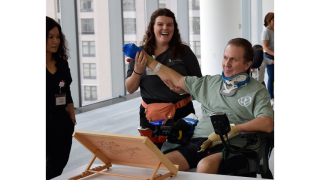Body
After experiencing an injury or with any chronic disease, it is common to experience deconditioning, a physical and/or psychological decline in function. Prolonged bed rest and inactivity can affect nearly all systems of the body.
Some of these effects include:
–Cardiovascular (heart): decrease in cardiac output, faster heart rates at rest and with activity, decreased blood pressure in upright positions (orthostatic hypotension), decreased ability to exercise.
–Pulmonary (lungs): mild lung collapse, pneumonia, decreased oxygen to the organs (hypoxemia), increased difficulty breathing with activity and at rest.
–Muscles and bones: decreased muscle size, increased weakness (atrophy), osteoporosis, contractures, osteoarthritis, loss of flexibility.
–Digestive (gastrointestinal and bowel): loss of appetite, constipation.
–Urinary: loss of bladder control (incontinence), bladder infection, electrolyte imbalance.
–Blood: tendency to develop blood clots (thromboembolism), blood thickening (increased blood viscosity).
–Endocrine: impaired response to insulin, high blood sugar (hyperglycemia), nausea.
–Skin: pressure ulcers or wounds.
–Functional: decrease performance in Activities of Daily Living (ADL) and activity endurance, impaired balance and coordination.
–Psychological: confusion, disorientation, anxiety, depression.
These changes can affect the ability to do self care, to walk, to engage in leisure activities and to work. Rehabilitation is the process that provides relief from the effects of deconditioning. Goals of rehabilitation include reconditioning and improving physical and psycho–social functions.
Patients and the rehabilitation team develop an individualized exercise program. This program is designed to:
– improve joint flexibility
– build muscle and muscle tone
– improve heart and lung function
– increase general endurance
– improve mood
– build strength and muscle.
The doctor and rehabilitation team may also review energy conservation and work simplification techniques to assist patients with enjoying life and meaningful activities. Through participation in an individualized rehabilitation program that addresses the whole person and his or her individual needs, patients may hope to achieve improved quality of life. Prior to participating in any exercise program, check with your healthcare provider.
References :
Casaburi, R. Impacting patient–centered outcomes in COPD: Deconditioning. European Respiratory Review 2006; 99: 42–46. DOI: 10.1183/09059180.
LeMone, P., Burke, K. & Bauldoff, G. (2011). Medical Surgical Nursing: Critical Thinking in Patient Care. 5th ed. Boston, MA: Pearson.
Rimmer, J.H., Schiller, W., & Chen, M.D. Effects of disability–associated low energy expenditure deconditioning syndrome. American College of Sports Medicine. 2012; 40(1) 22–29.



